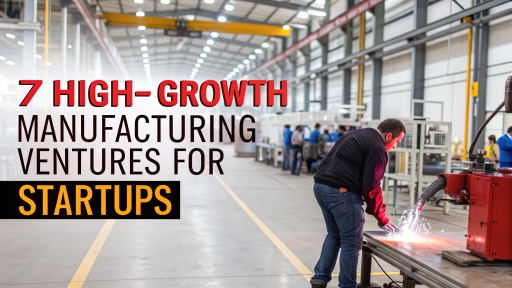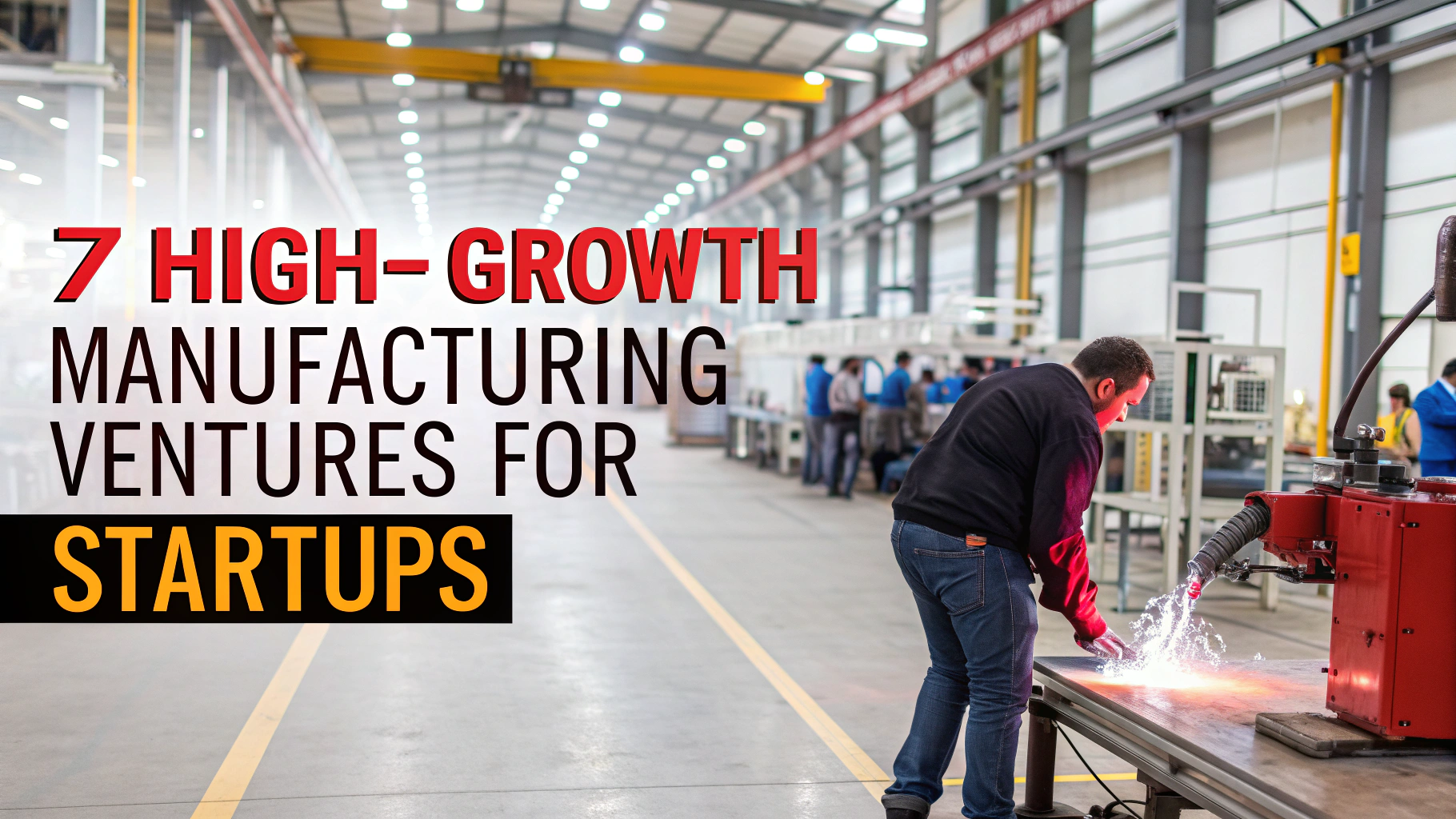Introduction: Navigating the Industrial Landscape for New Ventures
The industrial sector offers a wealth of innovation and opportunities for startups and entrepreneurs. This guide examines seven different industrial products and offers insights into their potential market, growth drivers, as well as opportunities for new High Growth Manufacturing. This guide will provide a roadmap to making an impact on everything from consumer product components to industrial chemicals.
Understanding the market dynamics, technological advances, and consumer changes is essential. The highlighted products represent industries that are transforming due to increased environmental awareness, technological innovation, or shifting supply chain requirements. Our goal is to provide entrepreneurs with the information they need to make informed choices, minimize risks and capitalize on new trends.
It is important for those who are embarking on the journey to have a good understanding of what’s going on in the market, such as its size, projected growth and contributing factors. Data visualizations will be used to provide market forecasts and analyses of demand, as well as growth projections. We will also discuss the practical aspects of establishing a manufacturing facility, including raw material sourcing and plant layout.
Niir Project Consultancy Services prepares detailed techno-economic feasibility reports for entrepreneurs who are looking to evaluate the feasibility of a new industry or business. These comprehensive reports provide critical information about the manufacturing process, raw materials, plant layout, and financials. They are a solid foundation for strategic planning.
View our Books on all Manufacturing ventures for more information
1. Sweet Supari: A Niche Market with Cultural Roots and Growing Appeal
Sweet Supari is a betel nut product that has been flavored and sugared. It holds a significant cultural significance in many South Asian nations. It is a popular digestive aid and mouth freshener, with a growing demand. Sweet Supari’s market is closely linked to that of areca nuts, the primary raw material.
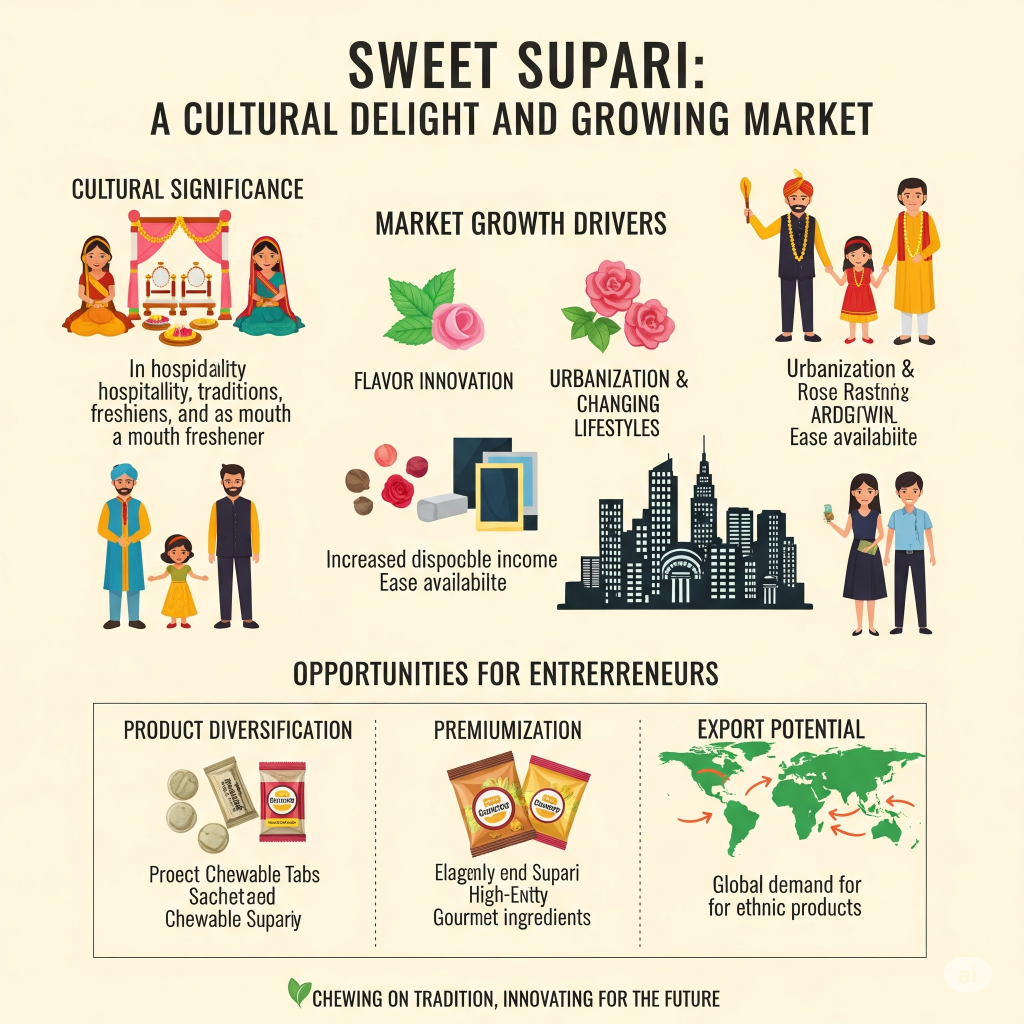
Market Overview and Growth Drivers
In 2024, the global market for areca nuts was estimated at USD 11.3 billion. Some projects indicate a modest CAGR between 2025 and 2034 of 1.2%, while others predict a USD 1.26 billion market by 2032, with a CAGR of 5%. In 2022, the market was valued at USD 11 billion, and a CAGR of 1.2% is projected from 2023-2032. This indicates steady growth.
Sweet Supari’s popularity is fueled by its use during traditional ceremonies, at social gatherings and for daily refreshments. The following are the key growth drivers:
- Cultural Significance: Deep-rooted cultural practices ensure consistent demand.
- Flavor innovation: New flavors and textures as well as packaging that appeals to younger demographics.
- Convenience: The ready-to-consume form makes it an accessible option.
- Urbanization and disposable income: Growing incomes in developing countries increase consumption.
Opportunities for Entrepreneurs
Sweet Supari Market Opportunities include:
- Product diversification: Create unique flavors by incorporating healthier and natural ingredients.
- Premiumization – Target niche markets with products of high quality, prepared hygienically, and packaged attractively.
- Export opportunities: Explore markets with a large South Asian Diaspora. India, Pakistan and Cambodia are the leading suppliers.
- Automated production: Investing in modern machines will ensure consistency, hygiene and scalability.
Challenges and Considerations
Regulatory hurdles, competitiveness, and maintaining consistency in quality are all challenges. It is important to source high-quality areca nuts. Opportunities abound despite challenges.
2. Aluminum Foil Containers – The Backbone of Modern Food Packaging
Aluminum foil containers are essential in food packaging because of their versatility, barrier properties and recyclability. These containers are used widely for take-out food, ready-to eat meals, and baked goods.
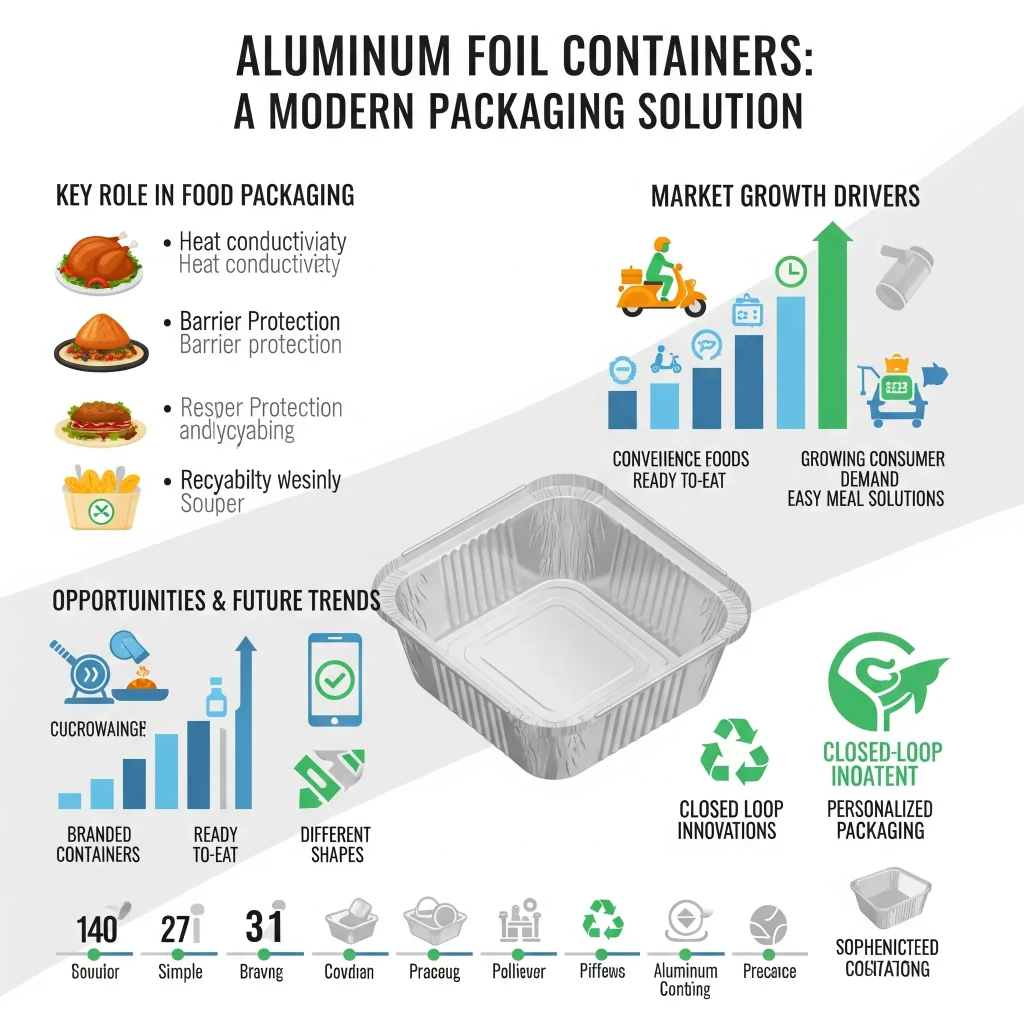
Market Overview and Growth Drivers
Global aluminum foil market is estimated to be USD 28.93 Billion in 2024, and will reach USD 45.67 Billion by 2033. This represents a 5.1% CAGR. Aluminum foil containers are expected to grow by 4.79% between 2022 and 2029. According to other estimates, the aluminum foil packaging market will reach USD 29.25 Billion in 2025 and grow at a CAGR of 4.94% up to USD 37.22 billion by 2030. Experts project the aluminum container market will grow from USD 3.5 billion in 2024 to USD 5 billion by 2033.
The following are key drivers:
- Growing demand for convenience foods: fuels demand for preferred packaging.
- Growth in Food Delivery Services: Depends heavily on these containers to ensure safe transportation.
- Sustainability trends: Aluminum is highly recyclable and therefore attractive to environmentally conscious businesses.
- Excellent barrier properties: Protects from light, moisture and oxygen.
- Thermal conductivity: Ideal for freezing, heating, and baking.
Opportunities for Entrepreneurs
You can find:
- Customized Solutions: Provide bespoke sizes, designs and printing options.
- Sustainable practices: Focus on recyclability, eco-friendly manufacturing and a focus on recyclability.
- Innovation in Design: Develop improved sealing mechanisms, compartmentalization, or aesthetic appeal.
- Invest in automation and efficiency: High-volume production at low cost can be achieved by investing in modern machinery.
Challenges and Considerations
The challenges include the competition from other materials for packaging, fluctuating prices of raw materials, and the recycling infrastructure. But inherent advantages and increasing awareness will ensure a promising future.
Related: Aluminium Foil Market Outlook 2025–2032: Growth Drivers and Forecasts
3. Monochloro Acetic Acid: A Vital Chemical Building Block
Monochloroacetic Acid (MCA), a vital organic compound, is used in a variety of industries from textiles to pharmaceuticals as a chemical intermediate.
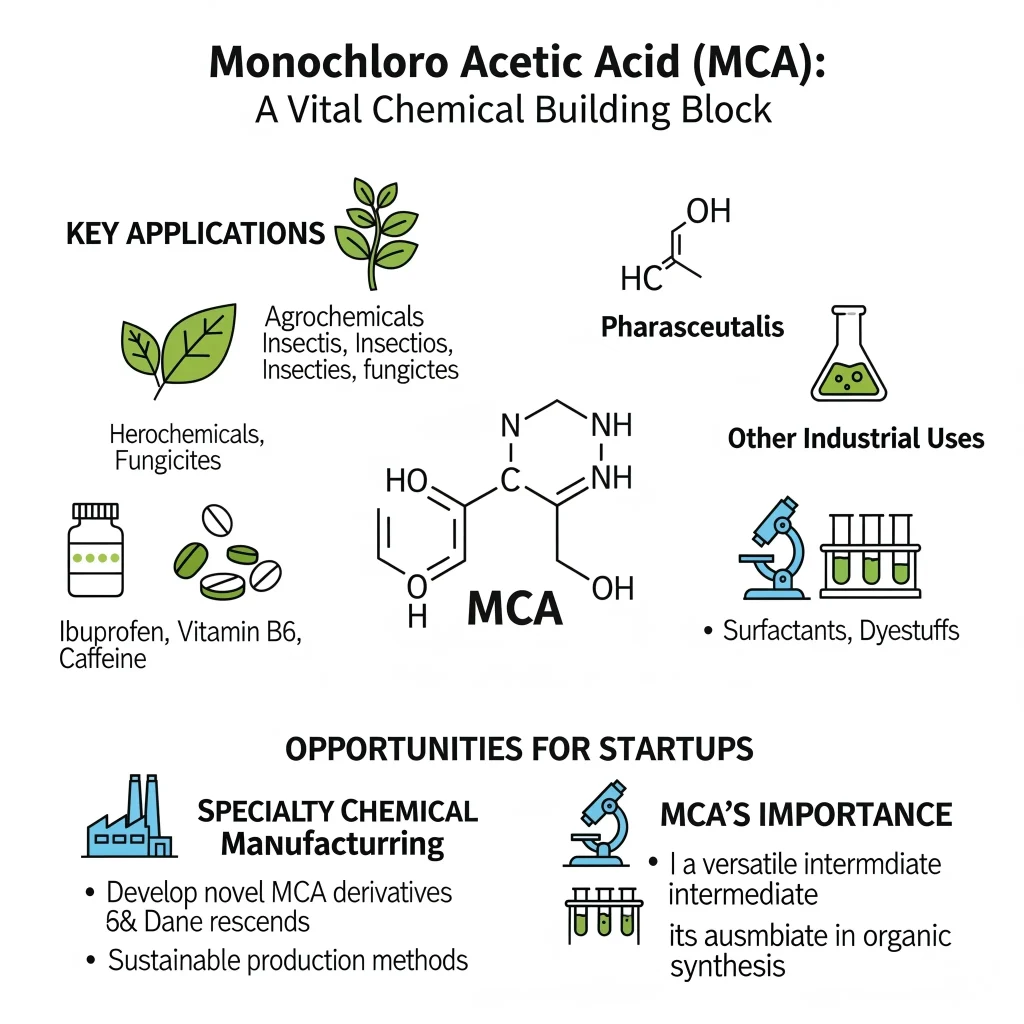
Market Overview and Growth Drivers
The MCA market is expected to grow from USD 932.95 in 2024 to USD 1132.34 by 2030. This represents a CAGR (Compound Annual Growth Rate) of 3.28%. More optimistic forecasts project the market will reach US$1,860.0 million by 2034, growing at a CAGR of 6.4%, while a third projection predicts the market will hit USD 1.2 billion by 2031 at a 3.9% CAGR.
The following are the key drivers of the MCA Market:
- Carboxymethyl cellulose (CMC), Production: Widely used in the food, textile, oil drilling, paper and other industries.
- Agrochemicals: key intermediate in herbicides such as 2,4-D or glyphosate.
- Pharmaceuticals: Ingredients used in the manufacture of different drugs.
- Personal care products: derivatives are used in cosmetics and detergents.
- Thioglycolic Acid Production: Applications for cosmetics, leather and animal feed.
- A shift towards energy-efficient practices: Influenced largely by wider industrial trends.
Opportunities for Entrepreneurs
You can find:
- Specialty Chemical Manufacturing: Concentration on high-purity MCAs for specific industrial applications.
- Derivative Production: Produce high-demand MCA derivatives like CMC.
- Research & Development: Investigate new applications or sustainable methods of production.
- Backward integration: In-house production can be used to reduce costs and secure supplies.
Challenges and Considerations
The challenges include the handling of hazardous chemicals, strict regulations, fluctuating prices for raw materials, and competition. But the constant demand for these products ensures that this market is stable and growing.
4. Disposable Cups and Plates Made from Sugarcane Bagasse: The Green Revolution in Disposables
Sugarcane bagasse disposable tableware has been thrust into the spotlight by a global push for sustainability. Bagasse is a fibrous residue of sugarcane that can be used to make eco-friendly tableware such as cups, plates and other items.
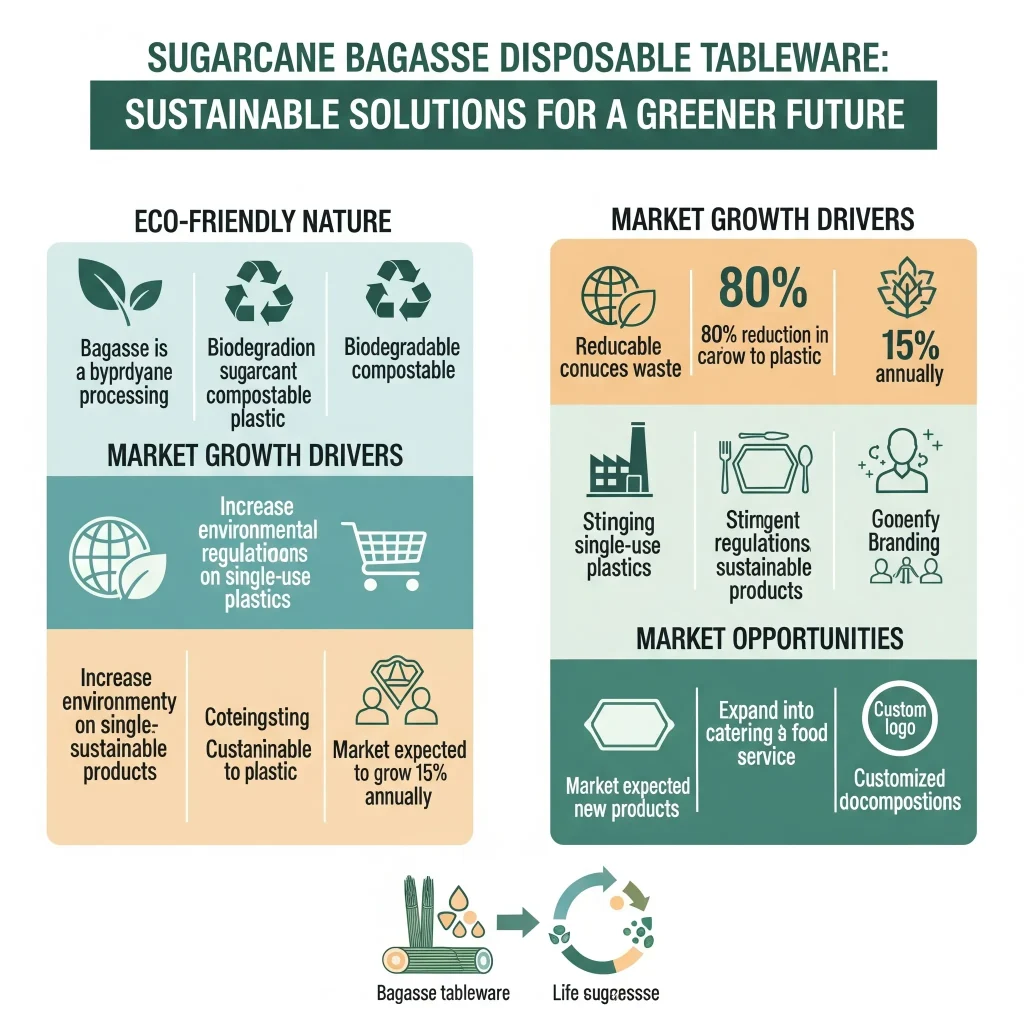
Market Overview and Growth Drivers
Globally, the biodegradable dinnerware market is expected to grow at an impressive CAGR of 7.6%. By 2030, it will reach USD 24,691.9. Analysts put the market at USD 18.62 billion in 2024 and forecast it will reach USD 21.81 billion by 2032, driven by a 7.6% CAGR. By 2034, it will reach a value of USD 14.96 billion.
The following are key drivers:
- Environmental Concerns and Regulations: Stricter regulations and increased awareness drive demand for sustainable alternatives
- Consumer preference for eco-friendly products: A growing segment actively seeks out environmentally responsible products.
- Food Service Industry Adoption: Restaurants and caterers switch to biodegradable alternatives
- Available Raw Material: Sugarcane Bagasse is an abundant and cost-effective source of raw material.
Bagasse tableware has a high level of performance. It is durable, oil-resistant, and can be used in the microwave, freezer, or even when frozen.
Opportunities for Entrepreneurs
You can find:
- Manufacturing Bagasse tableware: Set up production units for many products.
- Customized tableware can be branded.
- Distribution & Supply Chain: Establish an efficient network for retail, hospitality, and institutions.
- Innovation: Create new products with different shapes, sizes, and functions.
Challenges and Considerations
The challenges include managing bagasse supplies, competing with other biodegradable products, and ensuring quality. This venture is highly profitable due to the strong market demand.
Related: Business Plan Of Compostable Biodegradable Disposable Cups And Plates (Tableware) Using Sugarcane Bagasse
5. Crumb Rubber Powder: Turning Waste Tires into Valuable Resources
The recycling of waste tires into crumb rubber powder offers a sustainable alternative, turning waste into valuable raw materials for different industries. This creates a circular economy.
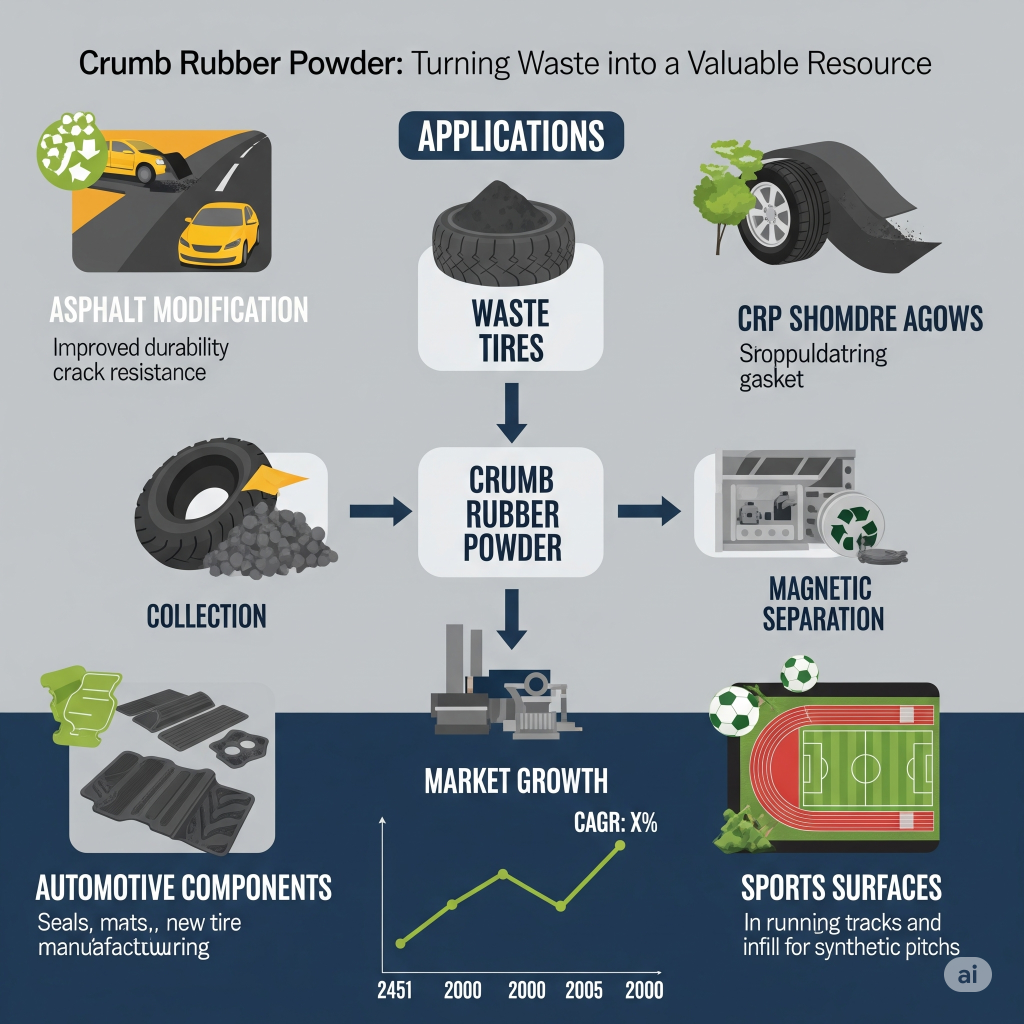
Market Overview and Growth Drivers
Tire recycling is a key component of the crumb rubber powder industry. This market will grow at a CAGR of 3.55% over the next five years. The crumb-rubber market was worth USD 1.77 billion in 2023, and it is expected to grow at a CAGR of 5.1% by 2030. According to another forecast, it could reach USD 4,2 billion by 2032 with a CAGR of 4.07%.
The following are key drivers:
- Environmental Regulations and Sustainability Initiatives: Drive Demand for Tire Recycling and Crumb Rubber Production
- Use in the asphalt modification of roads, playgrounds, and athletic surfaces.
- Automotive Industry Applications: Used in the manufacture of new tires and other parts.
- Infill material is popular for artificial turf fields in sports and recreation.
- Cost-Effectiveness: Recycled rubber is more cost-effective than virgin materials.
- Circular Economy Initiatives: Promote the growth of this industry.
Opportunities for Entrepreneurs
You can find:
- Crumb Rubber Manufacturing: Establish facilities for the processing of waste tires to various grades.
- Product Development: Innovative new uses for crumb rubber.
- Collection and logistics: Develop efficient systems to collect and transport waste tires.
- Partnerships: Collaborate closely with developers and construction companies.
Challenges and Considerations
The challenges include a capital-intensive installation, advanced processing technologies, and logistics for waste tire collection. The environmental imperatives, as well as the diverse applications of this venture, make it a promising one.
6. Eggshell Powder – A Sustainable Source of Calcium and Beyond
The eggshells that are often thrown away contain a lot of calcium carbonate. By converting them into powder, you can reduce waste while creating a product that is versatile for animal feed, food, pharmaceuticals and cosmetics.
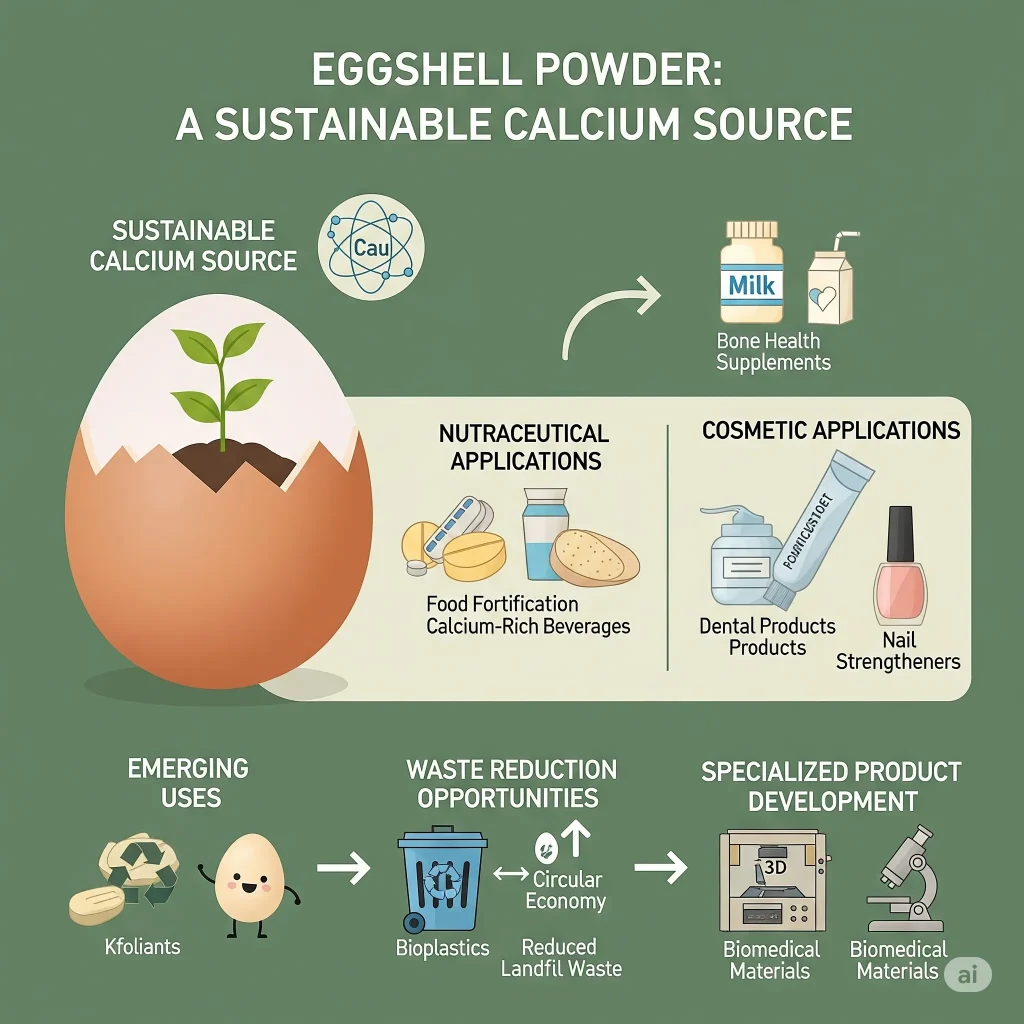
Market Overview and Growth Drivers
Due to its health benefits and wide range of applications, the market for eggshell membrane powder is on the rise. The Eggshell Membrane powder market is estimated to be worth USD 1.44 billion in 2024, and USD 2.80 billion by 2032. This represents a CAGR (Compound Annual Growth Rate) of 8.7%. Some projections indicate a growth of USD 1.8 billion from 2025 to USD 6.8 billion by 2035. This represents a 13.1% CAGR. This represents a 9.3% CAGR.
The following are key drivers:
- Nutraceuticals & Dietary Supplements: Excellent natural calcium source for bone health.
- Food Fortification: A method of fortifying food products.
- Cosmetics & Personal Care: The eggshell membrane has gained popularity in skin care and anti-aging.
- Animal feed: Calcium supplement for poultry, livestock and other animals.
- Waste Reduction & Circular Economy: Attractive to waste valorisation
- Increasing consumer awareness: Growing interest in organic and natural ingredients.
Opportunities for Entrepreneurs
You can find:
- Eggshell collection and processing: Set up systems to collect and process eggshells and turn them into high-quality powder.
- Specialized product development: Focus on pharmaceutical-grade calcium or cosmetic-grade eggshell membrane powder.
- Research and Innovation: Investigate new extraction methods or novel applications.
- Partnerships – Collaborate with cosmetic, pharmaceutical, and food companies.
Challenges and Considerations
The challenges include sanitation, logistics for raw material collection and meeting standards of quality. Growing demand and environmental benefits make it a promising endeavor.
7. Paper Bottles: The Future of Sustainable Packaging
Paper bottles are a revolution in sustainable packaging. They offer an eco-friendly option to plastics and glass. This helps to reduce plastic pollution.
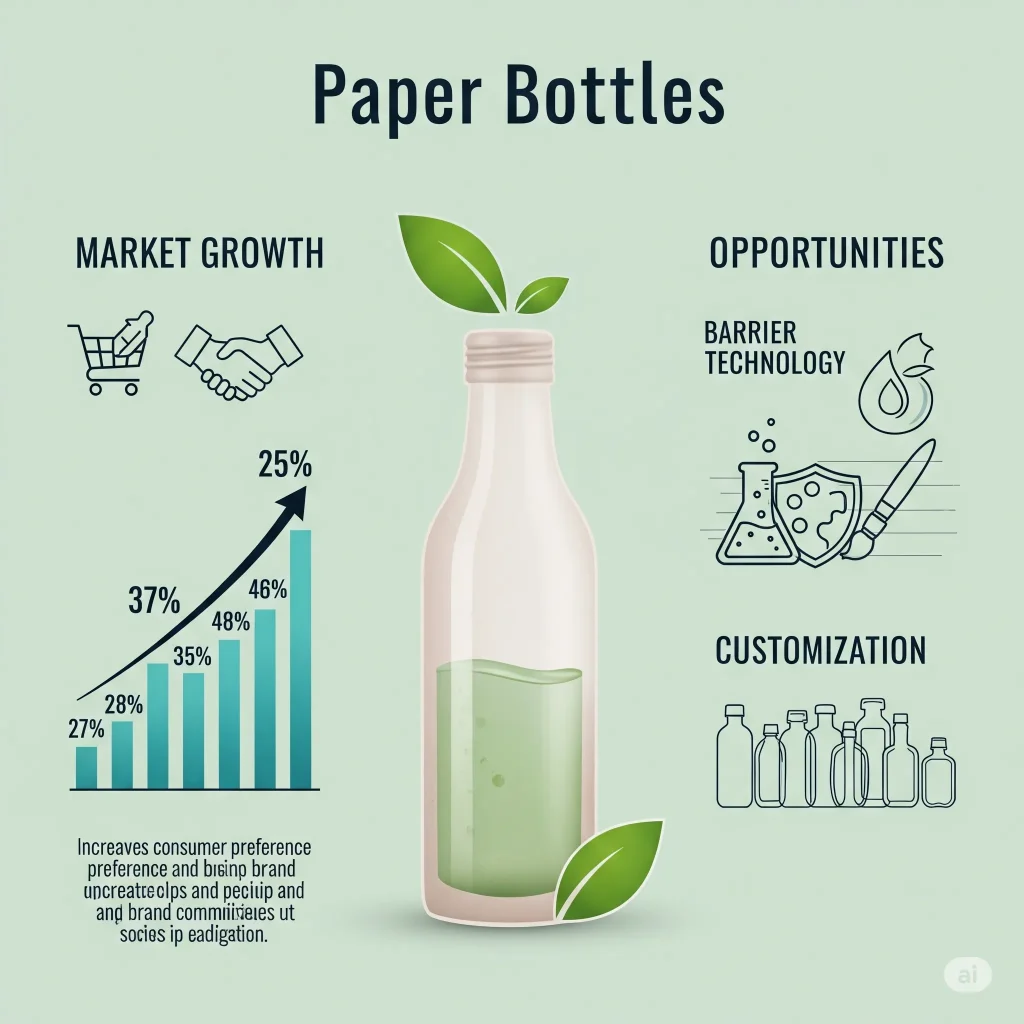
Market Overview and Growth Drivers
Paper bottles are on a growth trajectory. Globally, the paper bottles market is growing at a 5.6% CAGR from 2025-2032. It will reach USD 145.2 million by 2034. According to other projections, the market will grow from USD 72.22 million in 2023 up to USD 150.02 million by 2033 at a CAGR 7.6%.
The following are key drivers:
- Environmental sustainability: Urgent reduction of plastic waste and carbon footprint.
- Consumer preference for eco-friendly products: influences brand decisions.
- Major brands commit to sustainability by investing in paper bottles technology.
- Regulatory Support: Policies, regulations and other measures to promote sustainable packaging.
- Technological Advancements: Innovations on barrier technologies and manufacturing processes.
Opportunities for Entrepreneurs
You can find:
- Invest in infrastructure and technology to manufacture paper bottles.
- Developing Barrier Technologies: Specializing in eco-friendly, innovative barrier coatings.
- Customization and Design: We offer bespoke designs, branding solutions and bespoke design.
- Recycling solutions and end-of-life solutions: Develop efficient recycling procedures.
Challenges and Considerations
The challenges include developing barrier layers that are cost-effective, recyclable, and scalable, as well as competing with existing materials. Paper bottles will be a major player in the future.
For more information, check out our related video on Youtube
FAQs (Frequently Asked Questions)
Q1: Which are the most critical factors to be considered when starting a business in any of these sectors?
A: Several factors are important. Conduct a market analysis in order to determine the demand, pricing, and competition. Develop a business plan that includes production, sourcing raw materials, marketing and financial projections. Third, make sure you comply with all regulatory requirements. Last but not least, ensure adequate funding.
Q2: What is the best way to assess the financial viability of a project in manufacturing?
A: A detailed report on the techno-economic feasibility is vital. This report should include costs (machinery and raw materials, labor cost, utilities, overheads, etc.) as well as project revenue.
Q3: How important is technology in manufacturing?
A: Technology is the key to efficiency, sustainability, and quality. Modern machinery improves production efficiency and reduces waste. Technology is essential in chemical manufacturing to ensure safety and control. Advanced processing technologies are crucial for recycling ventures.
Q4: What is the importance of sustainability in today’s industrial landscape?
A: Sustainability is an imperative for any business. The government is implementing stricter regulations, and consumers are demanding eco-friendly products. Sustainability-oriented ventures have a competitive edge. Adopting sustainable practices improves the brand’s reputation and lowers operating costs.
Q5: How can I find reliable information and support to set up a new project in the industrial sector?
A. Organisations such as Niir Project Consultancy Services (NPCS), specialize in comprehensive support. They produce detailed market surveys and techno-economic feasibility studies covering all aspects of the project, from manufacturing to financial analysis. By engaging with a consultant, you can get expert advice and data to make informed decisions.
Market Overview: An Opportunity Snapshot
The following table provides a better understanding of the potential market. It summarizes important market data, including the current market size, projected growth and compound annual growth rates (CAGR). The table highlights the significant opportunities that new entrants have.
| Buy the Product | Current Market Size in USD | Estimated market size (USD) | CAGR (%) | Forecast Period |
| Sweet Supari | 11.3 Billion (2024) | 1.26 Billion (2032) | 1.2-5 | 2025-2034 / 2024-2032 |
| Aluminium Foil Containers | 28.93 Billion (2024) | 45.67 Billion (2033) | 4.79-5.1 | 2025-2033 / 2022-2029 |
| Monochloroacetic Acid (MCA) | 0.93 Billion (2024) | 1.86 Billion (2034) | 3.28-6.4 | 2024-2030 / 2024-2034 |
| Sugarcane bagasse can be used to make biodegradable disposable cups and plates (tableware) | 15.27 Billion (2023) | 24.69 Billion (2030) | 7.6-10.12 | 2023-2030 / 2025-2034 |
| Crumb Rubber Powder From Waste Tyre | 1.77 Billion (2023) | 4.2 Billion (2032) | 3.55-5.1 | 2024-2032 / 2024-2032 |
| Eggshell Powder | 1.44 Billion (2024) | 6.2 Billion (2035) | 8.7-13.1 | 2025-2032 / 2025-2035 |
| Paper Bottles | 0.07 Billion (2024) | 0.15 Billion (2033) | 5.4-7.6 | 2025-2032 / 2024-2033 |
Visualizing Market Dynamics
The following charts are a visual representation to further demonstrate the dynamics of the market and its growth potential. These charts highlight the current market size, projected growth and CAGR of each product.
This pie chart shows the current market share distribution among products. It gives a quick snapshot of their relative size. This chart helps to identify the dominant sectors and possible market entry areas.
Find Your Perfect Business Match Using Our Smart Startup Selector
Take Advantage of the Industrial Opportunity
Entrepreneurs have a wide range of options in the industrial landscape. Our analysis examined seven high-potential products: Sweet Supari (sugarcane bagasse), aluminium foil containers (MCA), sugarcane-bagasse disposable cups, sugarcane-bagasse disposable plates, crumb rubber powder from waste tyres, eggshell powder, and paper bottles.
Each product has its advantages and challenges, from the Sweet Supari culturally-rooted market to the rapidly growing biodegradable plateware sector. Aluminum foil containers are a great way to deliver food, and MCA is an important building block. Emerging markets such as crumb rubber and eggshell powder turn waste into valuable resources, fueling circular-economy growth.
The market data shows a range of growth paths, with CAGRs between 1.2% and 13.1%. These numbers highlight diverse opportunities that cater to varying investment abilities and risk appetites.
It takes more than just identifying potential opportunities to achieve success. Understanding manufacturing processes, regulatory requirements, the supply chain and customer needs is essential. For informed decisions and risk reduction, detailed feasibility studies are essential.
The industrial sector will change as we progress towards a future that is sustainable and technologically advanced. Entrepreneurs who anticipate change, adapt to new regulations and meet customer demands will be successful. These products provide business opportunities as well as the chance to contribute to an efficient and sustainable global economy.
For those who are ready to start, keep in mind that the key to success is thorough preparation, strategic thinking, and constant innovation. With the right approach, the industrial sector offers potential for profitable, lasting businesses that have a significant impact.

